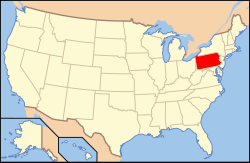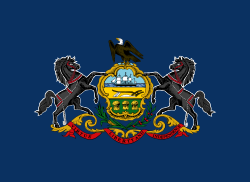
The following outline is provided as an overview of and topical guide to the United States Commonwealth of Pennsylvania:
Contents
- General reference
- Geography of Pennsylvania
- Places in Pennsylvania
- Environment of Pennsylvania
- Regions of Pennsylvania
- Demography of Pennsylvania
- Government and politics of Pennsylvania
- Branches of the government of Pennsylvania
- Law and order in Pennsylvania
- Military in Pennsylvania
- Local government in Pennsylvania
- History of Pennsylvania
- History of Pennsylvania, by period
- History of Pennsylvania, by region
- History of Pennsylvania, by subject
- Culture of Pennsylvania
- The Arts in Pennsylvania
- Sports in Pennsylvania
- Economy and infrastructure of Pennsylvania
- Education in Pennsylvania
- See also
- References
- External links
The Commonwealth of Pennsylvania is the fifth most populous of the 50 states of the United States. Pennsylvania lies west of the Delaware River in the Mid-Atlantic United States.
King Charles II of England granted William Penn a charter for a Colony of Pennsylvania in 1681. Philadelphia, the capital of the colony, soon rose to become the most populous city of British America. As Britain attempted to tighten its grip on its American colonies, many prominent Pennsylvanians called for greater independence for British America. The upper and lower counties of Pennsylvania (now known as Delaware) joined eleven other British colonies in declaring their autonomy with signing of the United States Declaration of Independence in Philadelphia on July 4, 1776.
The newly independent state chose the moniker "Commonwealth of Pennsylvania" as a token of its prominence and autonomy in the Americas. The American states prevailed in the American War of Independence which concluded with the Treaty of Paris of 1783. The Constitution of the United States was written in convention at Philadelphia in 1787. The State of Delaware and the Commonwealth of Pennsylvania became the first two states to ratify the new Constitution, thus Pennsylvania is ranked as the second state to join the Union.



